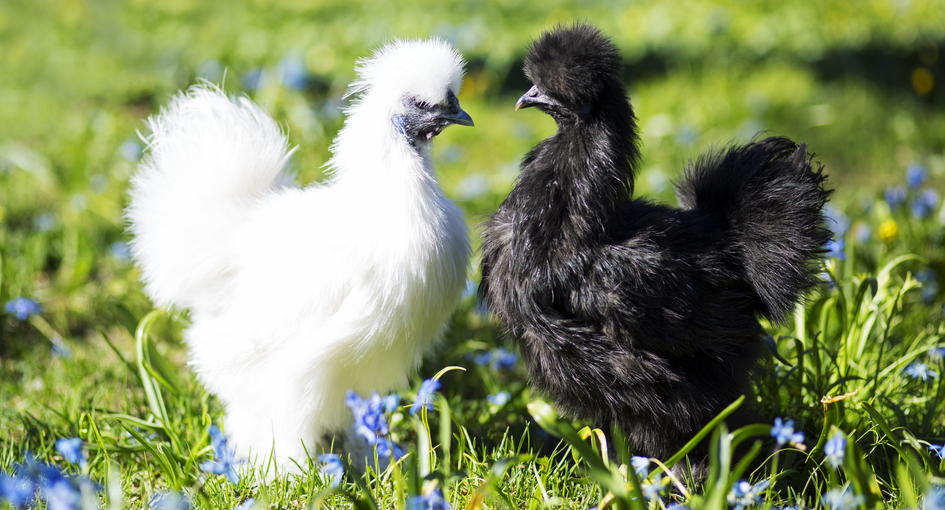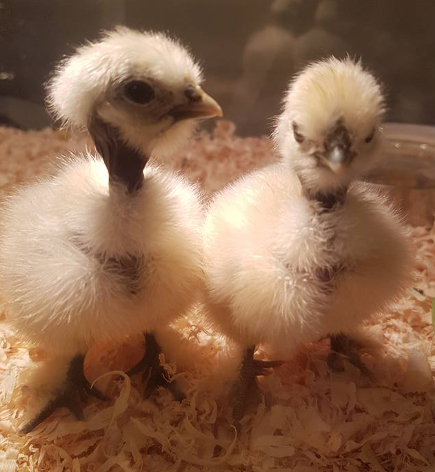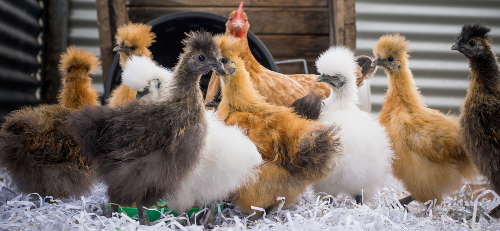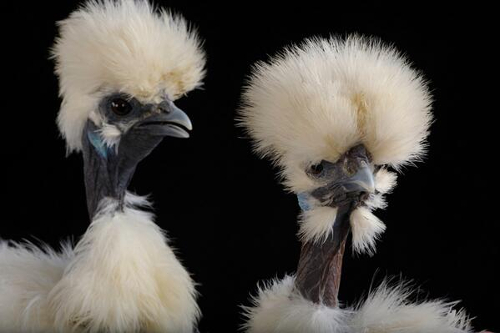Sexing Silkie chickens

Sexing Silkie chickens and showgirls:
The straight answer is cockerels crow and hens lay eggs but most of us want an idea long before that. Below is 7 ways to help and 9 more that might give you an idea.
There is no definitive method to sex a Silkie or showgirl chicken without resorting to vent sexing by a professional or DNA testing.
Sexing Silkies is made even more difficult because of the time Silkies take to mature and the fact that male and female Silkies also have similar features,colouring, feathers and plumage, The crest is common to both further obscuring some of the more obvious ways to tell the gender differences.
Below: Showgirl Silkies are even more difficult to sex.

In my personal experience, i can usually tell between 8-11 weeks. With sexing Silkies, the case is not so much "practice makes perfect" as practice tends to lend a better successful percentage.
All the methods I describe below are only to help give an indication of the sex of your bird(s). Never cull a bird from your flock until you are completely sure of whether it is a hen or rooster.
The 7 ways to sex Silkies
1: Both the male and female Silkie boast the fluffy crown of feathers on their head and this can be used in two ways to sex the birds.
When Silkies are young this crest looks very similar across the sexes but about 7 weeks of age the male will start to develop streamer feathers. These are single feathers that extend beyond the fluffy crest. The female will keep her neat rounded crest into adulthood.
Below: Can you sex this brood of Silkies?

The shape of the crest on newly hatched chicks may give an indication. Hens are very round and cockerels more square in shape.
2: Stature or body position. Silkie males tend to hold their bodies much more upright than Silkie pullets. The hen resembles a boat shape (more horizontally positioned) and the male is more upright keeping their chests forward and their necks elongated.
Below: This is a video of a male Silkie in close detail. Notice the streamer feathers and the large comb. The males are also thicker set and slightly taller.
Males will also hold their tail more upright. One way to assess this is see which birds in the group stand a little taller than the others, these are more likely to be the boys.
3: Size - Cockerels of the same age and colour will be larger overall. Males have larger feet, thicker legs, and longer hackle feathers than females. Silkie roosters will have long hackle feathers which are rough in texture.
4: Comb - In females, the comb comes in a more delicate “V” shape, where the male has a wider “U” shape. Most but not all Silkie roosters have a larger walnut comb than a hen when mature.
5: Wattle - Male Silkies will develop their wattle much sooner than females. It is easier to spot when you have a mixed flock of both pullets and cockerels of the same age.
You will see that some are developing a wattle where others aren’t. These early wattles belong to the boys. Females will develop much later. You won't see wattles until she is closer to her laying her first eggs.
6: Vent sexing - The vents of the sexes are very different to the trained eye.
7: Personality and behavioural signs - This requires time to sit and watch your birds in their natural environment and they need to be comfortable in your company otherwise they may not behave as they naturally would.
Below: A white Silkie hen with the rounder, fluffy crest and lack of streamer feathers.
While I’ve seen dominant personalities in both hens and roosters, in general, cockerels tend to be more bossy, louder, have tendencies to lead or show food, they may bite, and show curiosity earlier than pullets.
Below: A pair of Showgirl Silkies.

You will soon begin to notice behaviours in the males that you will not notice in the pullets.
There are 5 other ways that may work for you:
Lets start with looking at physical appearance in newborn chicks. A boy may be slightly bigger than a girl chick. It will have thicker, more sturdy legs than a female.
Wings - This is the one method that can be used early on in chicks that are less than a week old. In females, you will see just the tiniest little suggestion of primary wing feathers at the tip of the wing. In males, it remains as fluff until they are a bit older.
Feet - Females tend to have has very little feathering on her feet compared to males.
The Spurs - Silkie cockerels usually have them and the females usually won't. They don't normally show until they are around 6 months old.
Crowing - Silkie roosters start crowing around 3 to 5 months of age. Mine are quite loud but don't crow often. Don't let anyone tell you their crows are meek compared to that of large chickens.
Silkie boys, as do most roosters, have a natural instinct to protect their flock. Most Silkie roosters are docile ,to a degree but will do things like raising their hackle feathers.
Tidbitting - Is a behaviour you only get from roosters or hens with chicks. It is the loud clucking to call others to food. They will pick up a piece of food, drop it, pick it up, drop it, until they have the girls or chicks paying attention enough to come over and claim the piece of food.
If you have a hen with chicks you already know they are hens and not cockerels.
Mating - Cockerels can start mounting hens from as early as 3 months old.
Roosters will drop a wing and shuffle around the hen until she submits or runs away. This behaviour is best observed in the morning. This is the mating dance of chickens and only the males do it.
Boys will need more room as they start to chest bump the others and hopping around the brooder. Females will chest bump too but it is really more of a boy thing. Males will continue to be more outgoing and curious.
The Tail - Silkie females typically have rounder and softer tails than the males. Silkie males usually show a more pointed tail because of the presence of more normal or hard feathers in their tails.
The last resort.
If all else fails and you are really desperate to know then there are expensive but very accurate blood tests that can be performed to sex your chickens.
Remember – until the eggs appear in the nest,you are guessing as to gender. These guesses are based on observation but nothing is 100% accurate unless you have a DNA test done. These hints should help you make a guess as to what sex your Silkie chicks is, but do not be surprised if your little pullet suddenly begins to crow!
